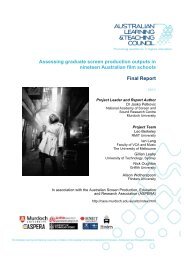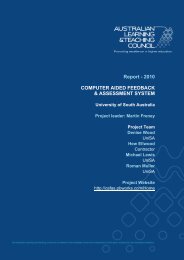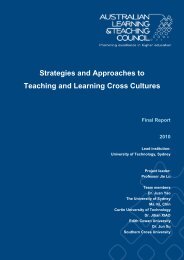student feedback and leadership - Office for Learning and Teaching
student feedback and leadership - Office for Learning and Teaching
student feedback and leadership - Office for Learning and Teaching
You also want an ePaper? Increase the reach of your titles
YUMPU automatically turns print PDFs into web optimized ePapers that Google loves.
Part A: Developing a Distributed Leadership Model - Secton 3: Building Leadership Capacity––Several RMIT internal projects, Work Integrated <strong>Learning</strong> <strong>and</strong> GraduateCapabilities, have a adopted a participative <strong>and</strong> collaborative multi-level<strong>leadership</strong> model to in<strong>for</strong>m new policy <strong>and</strong> procedures.A further important change has been the development of supportive systems<strong>and</strong> procedures to recognise <strong>and</strong> reward academics <strong>for</strong> taking <strong>leadership</strong>in learning <strong>and</strong> teaching:––In December 2008 the DVC(A) announced a new emphasis on the weightgiven to the contribution of teaching in promotion decisions. This is to beachieved by a broadening of emphasis that will require some combinationof teaching, <strong>leadership</strong> <strong>and</strong> scholarship in all academic promotions (exceptin the case of research-only appointments). The new approach relies uponthe following definitions of teaching, <strong>leadership</strong> <strong>and</strong> scholarship:––<strong>Teaching</strong> refers to the practice of teaching <strong>and</strong> requires evidenceof excellent per<strong>for</strong>mance in <strong>student</strong> outcomes, such as progressionrates, <strong>student</strong> <strong>feedback</strong> measures <strong>and</strong>, where applicable, successin higher degree supervision.––Leadership refers to motivating, influencing <strong>and</strong> inspiring othersto achieve the goals of the University. The promotion applicationshould evidence <strong>leadership</strong> aligned with the emphasis the applicanthas placed on his or her teaching, research or both. For thosewishing to emphasise teaching, there should be solid evidenceof <strong>leadership</strong> related to teaching, such as per<strong>for</strong>mance in courseor program innovation, design <strong>and</strong>/or co-ordination; or in mentoringor supervising teaching staff.––Scholarship refers to the generation of knowledge <strong>and</strong> itsapplication to the solution of real world problems. It includesExcellence in Research <strong>for</strong> Australia (ERA) indicators <strong>and</strong>/or learning<strong>and</strong> teaching inputs <strong>and</strong> outputs. <strong>Learning</strong> <strong>and</strong> teaching inputs<strong>and</strong> outputs can be operationally defined as those that wouldbe accepted by ALTC as teaching citations, ALTC grants, newcourseware, websites, presentations, <strong>and</strong> dissemination strategies.This important change illustrates the opportunity to triangulate reward <strong>and</strong>recognition of academic excellence via internal <strong>and</strong> external awards. Figure13 presents a framework to provide such an accreditated process. The 2008RMIT University <strong>Teaching</strong> Awards included an award <strong>for</strong> Student Centred<strong>Learning</strong> in the Business discipline to one of the ART members. This awardwas made <strong>for</strong> the innovative teaching practice he introduced as part of thisproject.Page 63
















